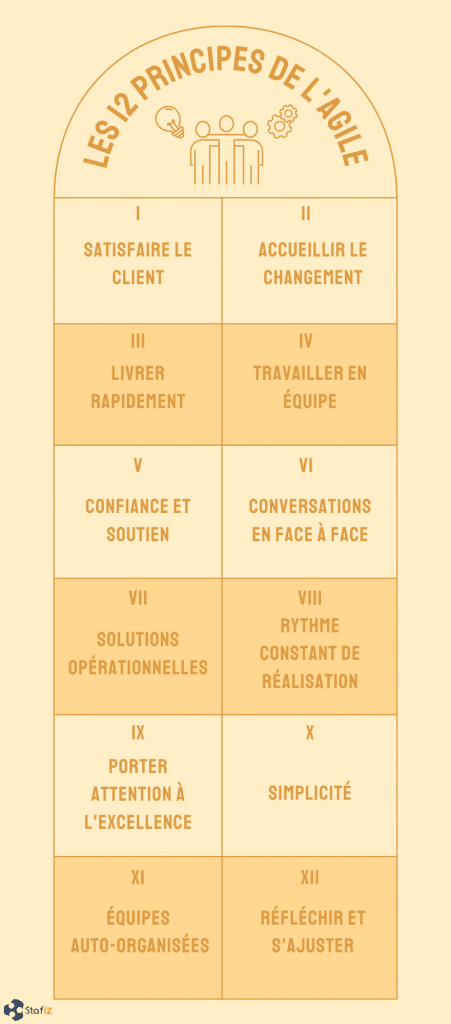The agile method for a more efficient team

The agile method is often used in project management because it guarantees a certain speed and flexibility. To set it up, the team must be solid and versatile. An agile team is made up of a set of people who have all the skills necessary to work, test, and develop projects. The team must be well trained in agile practices in order to deliver products or projects as quickly as possible. Here are the reasons why consultants choose an agile framework for their projects:
- They are more productive
- Customer expectations and goals are better met
Unlike other project management methods, agile allows teams to plan throughout the project. This makes adjustments easier and changes less disruptive. An agile team is often highly recommended for companies that work in a fast-paced environment and have very tight deadlines. This is even more true in the technology industry where agile methods and teams are favored for their innovative and adaptable conditions.
Build an agile team:
An ideal agile team typically consists of 3-10 people who are highly skilled and willing to work closely together until the end of the project. These people must have different expertise such as design, programming, analysis, etc. This team must be disciplined and willing to share failures and successes together during the project.
There is a manifesto with 12 principles and 4 values that the team must respect.

How does an agile team work?
Agile is a method that requires the project to be broken down into several shorter objectives. Team members achieve each of these goals one after the other with the goal of achieving overall success for the project. Here are two ways to run an agile project.
- Scrum
- Kanban
Both methods provide a better view of tasks that are in progress, overdue, or completed. Here are also some characteristics of the agile workflow that should be followed by the agile team:
Meetings:
These team-organized meetings are used to discuss together what works, what work has been done, and what tasks remain to be done. It is an opportunity for everyone to share their doubts and questions with others. But also to take stock of the actions to be taken for the next 24 hours and to discuss the obstacles to be overcome.
The objectives:
As mentioned earlier, it is required to break down the lenses in order to make them shorter. These are carried out in the shorter term and are examined later to see the results. Any changes to these goals should be shared at the daily meeting.
Agile teams should maintain consistency and quality of work by using peer review and executive feedback. Evaluations are organized before and after the completion of short objectives.
A vision of its role:
Projects with shorter goals and tighter schedules get the most out of this method because it increases team coordination. Having a vision of the next steps to take is essential. It is important that everyone knows their role and that it is clear to everyone. However, this does not prevent you from remaining flexible enough to allow team members to make crucial decisions and exceed expectations.
The agile method with Scrum :
When teams follow the Scrum framework, they are more focused on results. Ideally, 5-6 members make a good team, and there are 3 roles to assign:
1) The Project Owner:
The project owner is the great captain. This is often a company executive or one of the project stakeholders. His responsibility is to help his team achieve long-term goals in line with the vision of the project he has created. He remains in direct communication with his team to inform them of any progress of the project.
2) Scrum masters:
They are like the captain's lieutenants in the project. This role is very similar to that of a project manager. They should oversee the entire process, provide feedback, and guide team members as needed. Scrum masters take care of the day-to-day functions related to the project. They update the Scrum boards and the project's targets.
3) Team members:
They complete the project and their role is to leverage their skills to complete the tasks and achieve the objectives assigned to them, while meeting deadlines.
Read the article and watch the video: 5 phases of project management
How to be an effective agile team ?
It is the team's responsibility to follow the manifesto. The values and principles of agile lead to a sustainable outcome. There are also other practices that help the agile team be highly effective, such as:
- Sharing experiences and knowledge:
Since agile is technology-driven, there are tools to get familiar with: Team members need to share their expertise with others to speed things up. In addition, it helps to build trusting relationships within the team and ensures better collaboration. This can be done through presentations, practical applications, etc.
- Organizational change management:
When companies go through transformational change, employees need to keep a positive attitude throughout those changes and contribute. It's important for agile teams to adapt and alter their plans as needed. These changes need to be relayed to stakeholders to improve collaboration and help them understand the culture and the business as a whole.
- A positive work culture :
Team members need to trust each other and be open. This will allow them to come up with new ideas to take the project to the next level. Celebrating successes and maintaining friendly relationships at work will reduce conflict and problems within team members. At the same time, applying this culture between shareholders and team members is an important success factor.
- Self-organized teams:
To execute the work, tasks must be assigned to the different team members so that they can achieve the short-term goals of the project. They are trusted to make appropriate decisions, and everyone must be confident and ready to go the extra mile to get through the sometimes complex stages of the project.
Conclusion:
Ultimately, the people on your team are as important as the plan and structure of your project. It's essential to assign members the roles they excel at and hold them accountable for achieving their goals. This will achieve the best possible results for a project and the team will gradually improve its performance.
To keep a team up and running, it's crucial to resolve issues between people in the group. Train your teams on Scrum and Kanban methods. To stay in sync with agile best practices, follow the agile manifesto.



